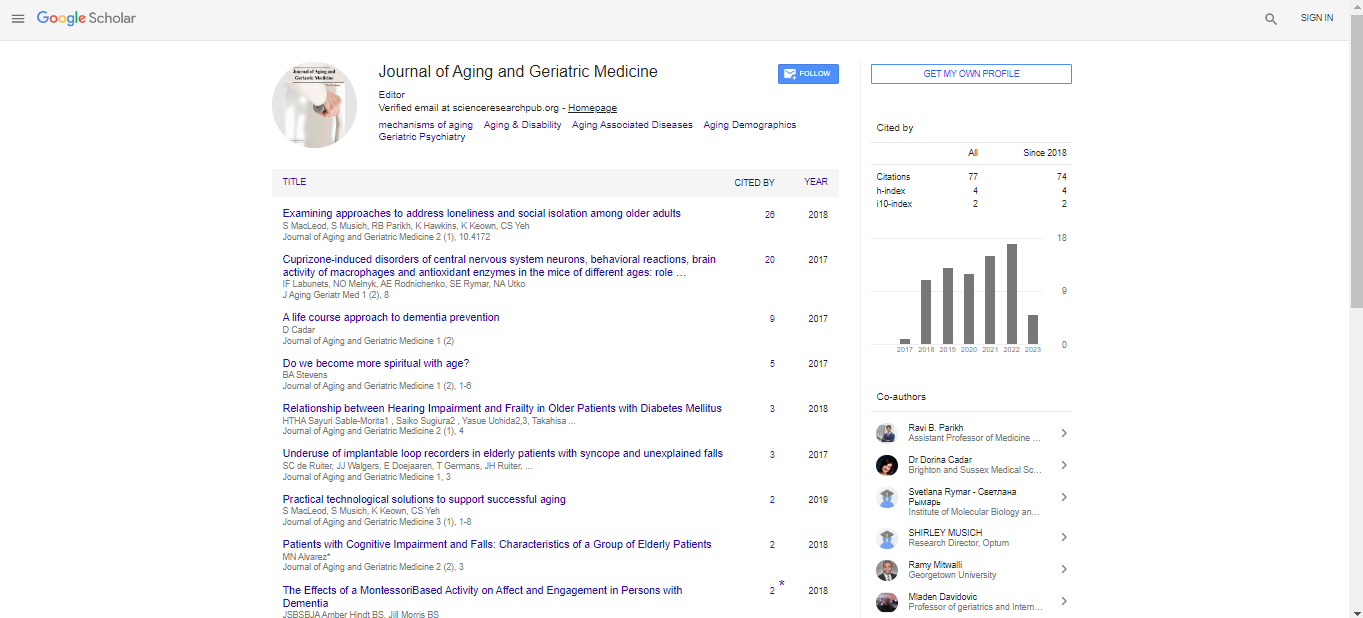Editorial, J Aging Geriatr Med Vol: 8 Issue: 1
Incontinence: Understanding a Common but Often Overlooked Condition
Lechuang Chen*
Department of Social Preventive Medical Sciences, University of California, Berkeley, United States
- *Corresponding Author:
- Lechuang Chen
Department of Social Preventive Medical Sciences, University of California, Berkeley, United States
E-mail: chen324@gmail.com
Received: 01-Jan-2025, Manuscript No. agm-25-169746; Editor assigned: 4-Jan-2025, Pre-QC No. agm-25-169746 (PQ); Reviewed: 18-Jan-2025, QC No. agm-25-169746; Revised: 25-Jan-2025, Manuscript No. agm-25-169746 (R); Published: 30-Jan-2025, DOI: 10.4172/2576-3946.1000180
Citation: Lechuang C (2025) Incontinence: Understanding a Common but Often Overlooked Condition. J Aging Geriatr Med 8:180
Introduction
Incontinence, the loss of bladder or bowel control, is a widespread health issue affecting millions of people globally. Although more common in older adults, incontinence can affect individuals of all ages and genders. Despite its prevalence, it is often misunderstood, underdiagnosed, and undertreated due to embarrassment or misconceptions. However, incontinence is not a normal part of aging and, in many cases, it can be effectively managed or even cured.
Incontinence, the involuntary loss of bladder or bowel control, is a common but often under-discussed medical condition that can affect individuals of all ages, though it is most prevalent among older adults. It ranges in severity from occasional leaks during physical activity to a complete inability to control urination or bowel movements. Despite its frequency, many people suffer in silence due to the stigma, embarrassment, or the mistaken belief that it is a normal part of aging [1,2].
There are different types of incontinence, including urinary incontinence—which is more common—and fecal incontinence. Urinary incontinence itself can be further classified into stress incontinence (leakage during coughing or exercise), urge incontinence (a sudden, intense urge to urinate), overflow incontinence, and functional incontinence (due to physical or cognitive impairments). Fecal incontinence, while less common, can be equally distressing and is often linked to muscle or nerve damage, chronic constipation, or gastrointestinal disorders [3].
The causes of incontinence vary widely and can include pregnancy and childbirth, aging, menopause, prostate issues in men, neurological disorders, obesity, and certain medications. Lifestyle factors such as poor diet, lack of exercise, or excessive caffeine and alcohol intake can also contribute to the condition [4].
The impact of incontinence goes far beyond physical discomfort. It can significantly affect mental and emotional well-being, leading to anxiety, depression, social withdrawal, and reduced quality of life. However, it is important to recognize that incontinence is often treatable and manageable. With appropriate medical evaluation, lifestyle adjustments, physical therapy, and in some cases medication or surgery, many individuals can regain control and improve their daily functioning [5].
Incontinence should not be ignored or accepted as inevitable. Early recognition and intervention can lead to effective management and a better quality of life.
Discussion
Incontinence, the involuntary loss of urine or feces, is a prevalent and distressing condition, especially among older adults. It significantly affects physical health, psychological well-being, and quality of life. Despite its high prevalence, incontinence is often underreported due to embarrassment, stigma, or misconceptions that it is a normal part of aging.
Urinary incontinence is the most common type and can be categorized into stress, urge, overflow, functional, or mixed incontinence. Stress incontinence occurs when physical activities like coughing or sneezing increase abdominal pressure, causing leakage. Urge incontinence involves a sudden, intense urge to urinate, often linked to overactive bladder. Fecal incontinence, though less common, can be equally debilitating and is often related to muscle damage or neurological conditions.
The causes of incontinence are multifactorial. Age-related changes in bladder capacity and sphincter function, pelvic floor muscle weakness, neurological diseases (e.g., stroke, Parkinson’s disease), urinary tract infections, and certain medications can contribute to incontinence. In women, childbirth and menopause play significant roles, while in men, prostate enlargement is a common cause.
Incontinence has broad implications. Physically, it increases the risk of skin infections and falls due to urgent trips to the bathroom. Psychologically, it can lead to embarrassment, social isolation, anxiety, and depression. It also imposes a significant economic burden on individuals and healthcare systems.
Management requires a holistic approach including behavioral therapies (bladder training, pelvic floor exercises), lifestyle modifications, medications, and sometimes surgical interventions. Importantly, addressing incontinence can greatly improve patients’ dignity and quality of life.
In conclusion, incontinence is a common but manageable condition. Early identification and comprehensive treatment strategies are crucial to reduce its impact and support affected individuals in maintaining independence and well-being.
Conclusion
Incontinence is a common and distressing condition that affects individuals physically, emotionally, and socially. Despite its prevalence, it is often underreported due to stigma and lack of awareness. However, incontinence is not something that must be silently endured. With proper evaluation, individualized treatment, and ongoing support, most people can achieve significant improvement or even full control. Raising public and professional awareness, improving access to care, and encouraging open conversations about bladder and bowel health are essential steps in addressing the burden of incontinence and improving the quality of life for those affected.
References
- Angelica VG, Tracy AM (2018) Screening for spontaneous preterm birth and resultant therapies to reduce neonatal morbidity and mortality: A review. Semin Fetal Neonatal Med 23: 126-132.
- Joice SM, Tricia SF, Raquel CGL, Veronica CV, Danielle SDM (2021) Premature birth: topics in physiology and pharmacological characteristics. Rev Assoc Med Bras 67: 150-155.
- Wen LL, Chang WH, Wang HW (2021) Risk factors associated with preterm premature rupture of membranes (PPROM). Taiwan J Obstet Gynecol 60: 805-806.
- Goligher, Ewan C (2012) Ventilator-Induced Diaphragm Dysfunction. Anesthesiology 117: 463â??464.
- Stein H (2013) Electrical Activity of the Diaphragm [Edi] Values and Edi Catheter Placement in Non-Ventilated Preterm Neonates. Am. J. Perinatol. 33:707â??711.
Indexed at, Google Scholar, Crossref
Indexed at, Google Scholar, Crossref
Indexed at, Google Scholar, Crossref
Indexed at, Google Scholar, Crossref
 Spanish
Spanish  Chinese
Chinese  Russian
Russian  German
German  French
French  Japanese
Japanese  Portuguese
Portuguese  Hindi
Hindi 